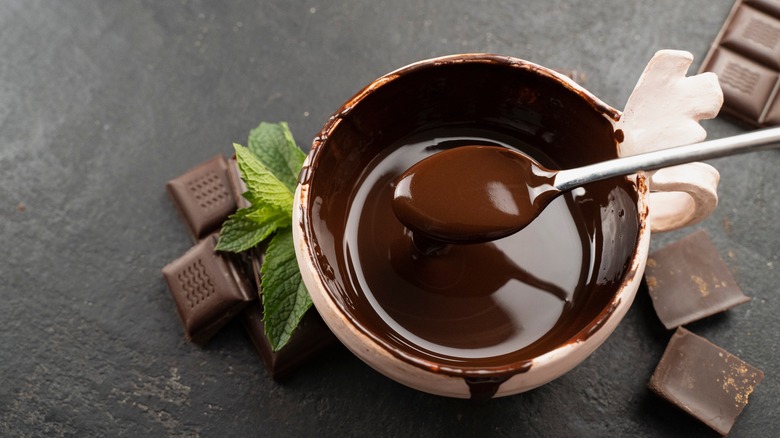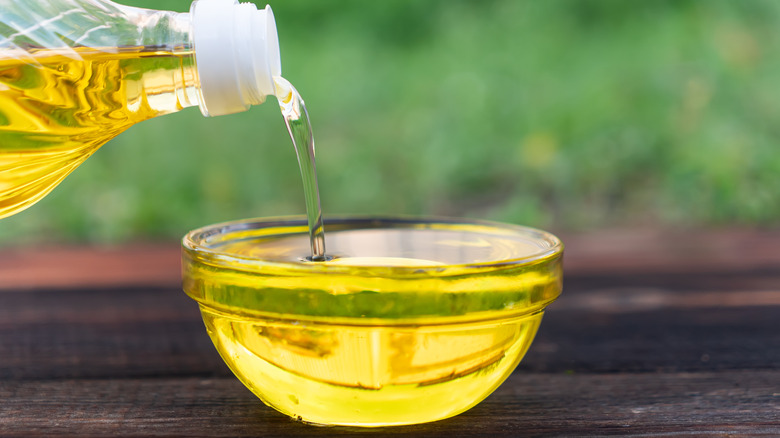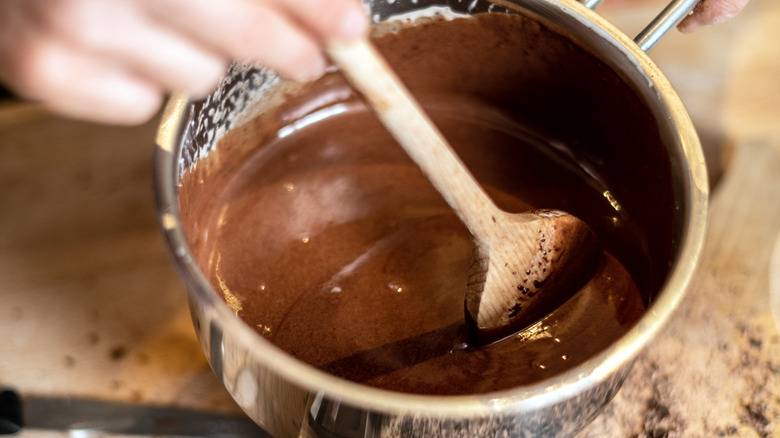The Easiest Way To Thin Out Melted Chocolate
Melted chocolate is good for more than just licking it off a spoon or dipping strawberries. You can fill candy molds to create fun decorative shapes or blend it with cream to top your cakes with some smooth ganache. However, if the chocolate becomes a little too thick to use after melting, you can thin it by adding extra fat. Not only will this enhance the chocolate's texture, making it smoother and richer — thereby facilitating easier drizzling on desserts — but it can also improve the final appearance, giving your confection a glossier look.
Cocoa butter is ideal for preserving the chocolate's flavor and texture because it is a natural component of cocoa beans, meaning it integrates well with melted chocolate. Sold in solid chunks, the simplest way to melt cocoa butter is to use a cheese grater to grate it into smaller pieces. Gradually mix the fat into the chocolate until it melts into a smooth, pourable texture. If you don't have cocoa butter on hand, though, other neutral oils can work in its place.
Stick to mixing in neutral flavors
For easier incorporation of cocoa butter, heat the chocolate and fat separately. Then, spoon small amounts of the melted fat into the chocolate, mixing thoroughly until it reaches a smoother consistency. While cocoa butter may be your best bet for keeping chocolate consistent, it's often pretty pricey — a pound can cost nearly $15, depending on the brand. Fortunately, you can supplement the fat with more affordable options. Cooking oils are liquid at room temperature, making them easy to pour into the melted chocolate.
Be sure to swap in a neutral-tasting cooking oil, like canola or a vegetable oil blend (made from soybean and other plant-based oils). These prevent any unwanted flavors from seeping into your dessert. Coconut oil can work, though it might impart a slightly fruity taste. Avoid stronger-tasting oils, like olive or peanut oil, altogether.
If you know in advance that the candy will need to be thinned out, add the oil along with the solid chocolate before the melting process begins. This allows the entire bowl to heat evenly, ensuring smoother mixing once the dessert begins to break down.
Two major reasons chocolate might thicken
Two common mistakes can cause your chocolate to thicken up. The first is overheating the chocolate as it's melting; it may solidify and become difficult to mix. Dark chocolate burns past 120 degrees Fahrenheit, while milk and white varieties burn at 110 degrees Fahrenheit. As it scorches, the chocolate separates into thick pieces that added fat can help remedy.
The other reason melted chocolate may begin clumping is if it has seized. When stirring the confection with added fat, make sure all utensils and bowls are completely dry and water-free. Adding even a tiny bit of water to melted chocolate will cause it to seize and thicken. Chocolate doesn't contain any water, so any added liquid causes its sugars and fats to bind into separate pieces.
It may seem illogical, then, to use boiling water to fix seized chocolate. However, adding the hot liquid gradually to your lumpy chocolate can melt down those clumps, allowing it to be whisked back to a smooth texture. The flavor may be slightly less rich than if you used cocoa butter, but this method can be useful for sauces or piped decorations.



